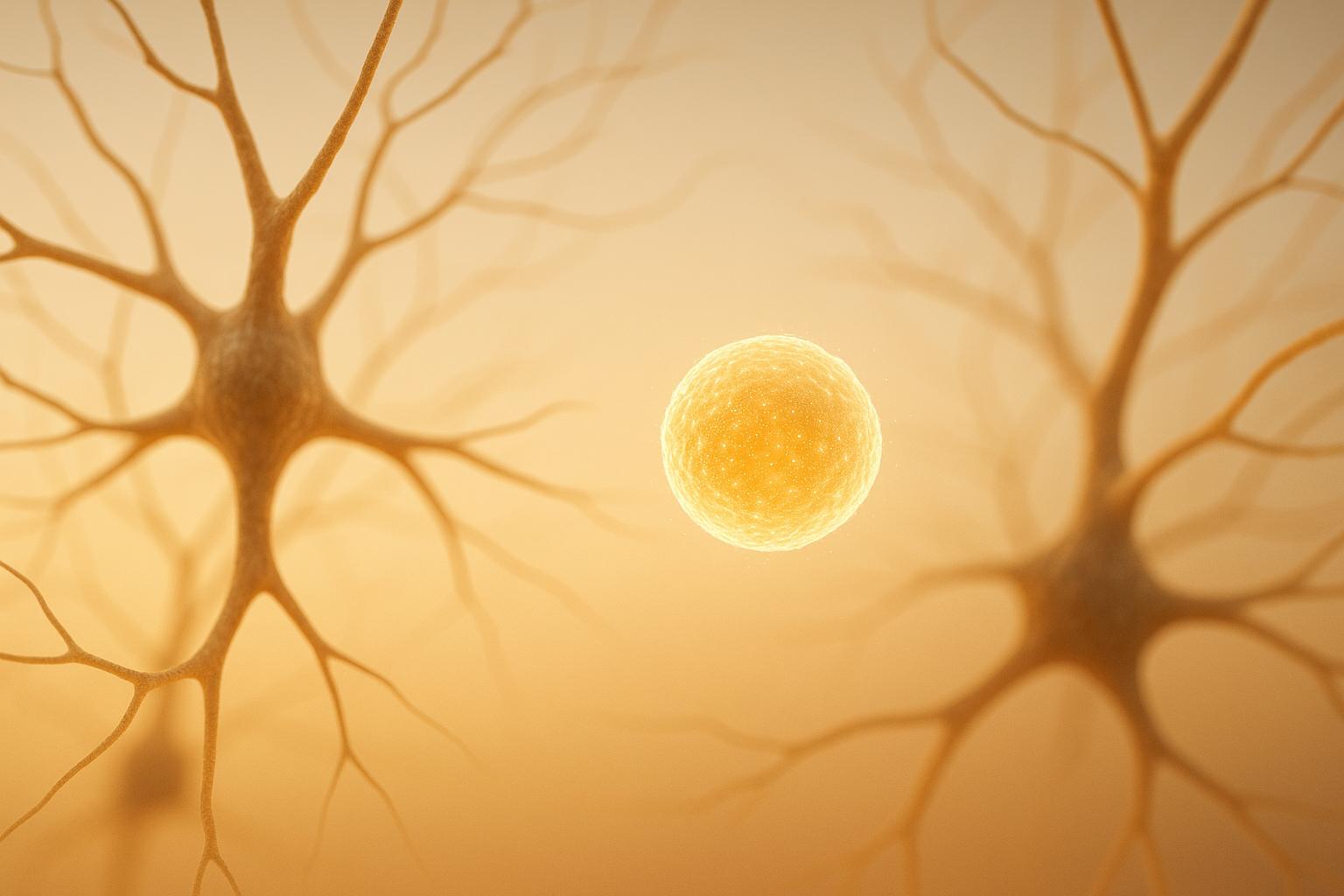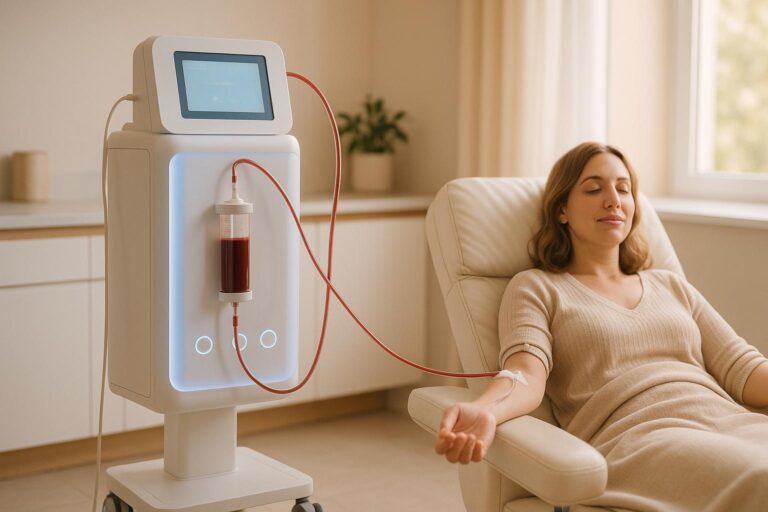Exosome therapy is changing how we approach neuroinflammation. These tiny vesicles, derived from stem cells, can cross the blood-brain barrier to deliver anti-inflammatory molecules directly to damaged brain tissue. Unlike traditional stem cell treatments, exosomes are easier to handle, store, and administer, while reducing risks like immune rejection. They also regulate brain immune cells, promote neuron survival, and support tissue repair.
Key takeaways:
- What they do: Exosomes calm overactive brain immune cells (microglia and astrocytes) and repair neural damage.
- How they work: They deliver proteins, RNA, and growth factors to suppress inflammation and aid recovery.
- Advantages: Easier storage, safer use, and natural ability to reach the brain.
- Challenges: Standardizing production, ensuring consistent quality, and addressing regulatory hurdles.
Early research and clinical trials show promise for treating conditions like Alzheimer’s, stroke, and multiple sclerosis. However, large-scale production, long-term safety, and cost remain areas for improvement.
How Exosomes Work in Neuroinflammation Treatment
Effects on Brain Immune Cells: Microglia and Astrocytes
Exosomes play a crucial role in regulating brain immune cells, particularly microglia and astrocytes. They help shift overactive microglia into a state that supports tissue repair and reduce the scarring caused by astrocytes. At the same time, they encourage the production of factors that aid neuron survival and growth. Research shows that exosomes derived from stem cells carry molecular signals capable of transforming microglia from a pro-inflammatory state to one focused on repair. Similarly, astrocytes exposed to these exosomes produce fewer scar-forming molecules and more substances that support neuronal health and regeneration.
Molecular Pathways Targeted by Exosomes
Exosomes don’t just act on cells – they also influence critical molecular pathways involved in neuroinflammation. They suppress the activation of NF-κB, a pathway linked to the production of inflammatory molecules like TNF-α and IL-1β, through the delivery of microRNAs and proteins. Additionally, exosomes modulate other pathways such as the NLRP3 inflammasome, JAK-STAT, and complement systems, helping to restore balance to the brain’s inflammatory response. By targeting these pathways, exosomes contribute to reducing harmful inflammation and promoting a healthier environment for brain cells.
Brain Protection and Repair Effects
Exosomes go beyond inflammation control – they actively support brain repair and protection. They deliver growth factors that enhance neuron survival and encourage the formation of new blood vessels (angiogenesis). They also improve mitochondrial function, which strengthens neurons against stress, and enhance synaptic plasticity, allowing for better communication between neurons. Moreover, exosomes play a role in restoring the integrity of the blood–brain barrier, a critical defense mechanism for the brain. Some studies even suggest that exosomes may trigger cell regeneration, offering additional support for brain recovery and resilience in challenging conditions.
Research Evidence for Exosome-Based Treatments
Results from Laboratory and Animal Studies
Studies in the lab and with animal models have shown promising results for stem cell–derived exosomes in treating neurological conditions. In stroke models, exosomes have been found to reduce tissue damage, decrease inflammation, and help neurons survive. Similarly, in models of Alzheimer’s disease, exosome treatments have shown potential to improve cognitive performance while reducing harmful markers like amyloid plaques and microglial activation.
For Parkinson’s disease, exosomes appear to protect dopamine-producing neurons and improve motor skills. Meanwhile, in spinal cord injury models, they promote axon regeneration and minimize scarring, pointing to their potential in aiding recovery from these injuries.
Human Clinical Trials and Current Progress
Encouraged by these preclinical results, researchers have initiated clinical trials to test exosome-based therapies in humans. Early-phase trials have demonstrated that these treatments are safe for neurological conditions. Phase II studies in stroke patients have shown better outcomes when exosomes are administered shortly after the event, while preliminary trials in multiple sclerosis have reported fewer inflammatory lesions. However, more research is needed to confirm these findings.
Trials are also underway for traumatic brain injuries, focusing on the safety of exosomes and their ability to improve cognitive recovery. Despite these advancements, there are still challenges to tackle – such as standardizing production methods, ensuring consistent dosing, and lowering manufacturing costs. Even with these hurdles, ongoing research continues to highlight the potential of exosome-based therapies as a new way to address neuroinflammatory conditions. These early findings pave the way for further investigation into their possibilities and challenges.
Benefits and Challenges of Exosome Therapy
Key Benefits: Targeted Treatment and Safety Profile
Exosomes bring several practical advantages to the table when compared to traditional treatments for neuroinflammation. One standout benefit is their low immunogenicity, meaning they are less likely to provoke unwanted immune responses. Unlike whole stem cell transplants, exosomes minimize the risk of immune rejection, sidestepping the complications associated with cellular rejection.
Another major advantage is their ability to cross the blood-brain barrier. This natural protective barrier often prevents drugs from reaching brain tissue, but exosomes can navigate through it with ease. This makes them particularly effective for treating neuroinflammation, where direct access to brain tissue is critical for success.
Exosomes also shine when it comes to storage and delivery. They remain stable under standard storage conditions without losing their therapeutic properties, unlike whole stem cell treatments, which require more complex preparation and storage protocols. This stability could help lower costs and make treatments more accessible.
Their targeted delivery capabilities are another game-changer. Exosomes can be engineered to carry therapeutic molecules directly to affected areas in the brain. This precision not only enhances treatment effectiveness but also reduces the likelihood of side effects.
Current Challenges: Standardization and Knowledge Gaps
Despite their potential, exosome therapy still faces several obstacles that need to be addressed before it can become a widely used clinical option. One major issue is the variability in exosome content. The therapeutic molecules inside exosomes can vary depending on factors like the source of the stem cells, the culture conditions, and the methods used to isolate them.
The lack of standardized production protocols is another hurdle. Without consistent guidelines for isolating, purifying, and characterizing exosomes, it’s challenging to compare results across studies or ensure reliable therapeutic outcomes.
Scaling up production for widespread clinical use is also problematic. Current methods are effective for research but fall short when it comes to producing therapeutic-grade exosomes at a large scale. High production costs further complicate efforts to make these treatments more accessible to patients.
Regulatory approval presents another challenge. Agencies like the FDA are still developing clear guidelines for exosome-based therapies, making the approval process lengthy and complex.
Finally, there are gaps in our understanding of how exosomes work at the molecular level. While their therapeutic effects are evident, the exact mechanisms behind their role in treating neuroinflammation remain unclear. These challenges highlight the complexities of exosome therapy, especially when compared to traditional stem cell treatments.
Comparison of Exosome vs Traditional Stem Cell Treatments
The table below outlines the differences between exosome therapy and traditional stem cell treatments, providing a snapshot of their respective strengths and limitations.
| Aspect | Exosome Therapy | Traditional Stem Cell Therapy |
|---|---|---|
| Safety Profile | Lower risk of immune rejection, no risk of tumor formation | Higher immune rejection risk, potential for unwanted cell growth |
| Storage Requirements | Can be freeze-dried, stable at standard temperatures | Needs specialized cryogenic storage |
| Delivery Method | Can cross blood-brain barrier naturally | May require invasive delivery methods for brain access |
| Scalability | Easier to mass-produce once standardized | Limited by cell culture capacity and viability |
| Regulatory Approval | Simpler pathway as cell-free product | Complex approval process for live cell therapies |
| Treatment Consistency | More standardizable once protocols established | Variable based on cell source and preparation |
| Cost Potential | Lower long-term costs | Higher costs due to complex handling requirements |
While exosome therapy offers several advantages, such as safety, scalability, and ease of delivery, traditional stem cell therapies still hold value, particularly because they have well-established protocols and a longer history of clinical use. Both approaches have their roles in regenerative medicine, with exosomes emerging as a promising option for specific treatments like neuroinflammation.
sbb-itb-d9e542d
Future Applications in Regenerative Medicine
Combining Exosomes with Other Regenerative Treatments
Exosome therapy is set to complement existing regenerative treatments, creating a combined approach to better healing outcomes. Researchers are actively studying how exosomes can amplify the effectiveness of current therapies when used together.
For instance, incorporating exosomes into hydrogels allows for a controlled and sustained release of therapeutic molecules over time. The hydrogel acts as a scaffold, slowly releasing exosomes, which helps maintain therapeutic levels in targeted areas for longer periods.
When paired with stem cell therapies, exosomes play a dual role: they help manage immediate inflammation while also promoting long-term tissue repair. This two-pronged approach addresses both short-term and extended healing needs, making it a promising strategy for regenerative medicine.
Another exciting avenue involves engineering exosomes with targeting ligands. This customization enables exosomes to deliver specific therapeutic payloads directly to targeted tissues or cells. This precision makes them an excellent complement to other regenerative treatments that may lack such targeted capabilities.
Exosomes, packed with a rich molecular cargo, open up numerous possibilities for combination therapies. By working in synergy with other treatments, they pave the way for more integrated and effective approaches in clinical settings.
Integration into Functional Medicine Practice
The versatility of exosome therapy aligns well with the holistic approach of functional medicine, where addressing multiple pathways is key. For example, exosomes’ ability to reduce neuroinflammation fits seamlessly into comprehensive care strategies.
Clinics specializing in regenerative medicine, like Kinnection Clinic, could incorporate exosomes alongside existing services such as IV therapy, hormone replacement, and other functional medicine protocols. Exosomes’ natural ability to deliver therapeutic molecules directly to problem areas makes them a valuable addition for tackling inflammation at its root.
To maximize their potential, exosome therapy can be integrated with nutritional plans, lifestyle changes, and other regenerative treatments. Imagine pairing exosome-based therapies with IV treatments to create a powerful combination for cellular repair and inflammation reduction.
The growing interest in exosomes is evident, with 150 clinical trials registered on ClinicalTrials.gov investigating their use for various conditions. Among these, 31 trials focus specifically on MSC-derived exosomes. This expanding research base offers functional medicine practitioners the evidence they need to incorporate exosome therapies into their treatment protocols.
Compared to synthetic nanoparticles, exosomes offer several advantages, including natural targeting abilities, reduced immune reactions, stability in biological environments, and their inherent ability to carry therapeutic molecules. These features make them particularly well-suited for personalized approaches in functional medicine.
Research Needs for Clinical Implementation
While the potential of exosome therapy is immense, several challenges must be addressed before it can be widely adopted in clinical practice. One major hurdle is the need for standardized production protocols and strict quality control measures to ensure consistent therapeutic results.
Variability in exosome content between production batches remains a significant concern. Scientists are working on refining production methods, such as using 3D culture systems for mesenchymal stem cells, induced pluripotent stem cell-derived neural stem cells, and HEK293 cells in bioreactors.
Scaling up production is another pressing issue. For instance, a single hollow fiber bioreactor unit can produce the same amount of exosomes as 70 T225 flasks in a week. While this demonstrates the potential for large-scale manufacturing, further improvements are needed to meet clinical demand while maintaining quality.
Another challenge is the short plasma half-life of exosomes, which is only 70 to 80 minutes. This rapid clearance by macrophages calls for innovative delivery systems to extend their circulation time and enhance tissue-specific targeting.
Safety concerns are also critical. These include potential risks such as immune reactions with repeated doses, tumorigenic risks, and the possibility of transmitting infectious agents. Long-term safety studies will be essential for gaining regulatory approval and building trust in these therapies.
Emerging technologies are showing promise in overcoming current limitations. For example, the EXODUS system has achieved exosome yields of 29.7% with relative purity of 44.4%, compared to 9.4% and 7.4% using traditional membrane affinity methods. Additionally, hypoxic culture conditions have been shown to enhance exosome yield by 1.5-fold at 12 hours and 1.9-fold at 24 hours.
New separation technologies, such as magnetic separation, microfluidic chips, and tangential flow filtration combined with size exclusion chromatography, are improving the precision, efficiency, and scalability of exosome production. These advancements suggest that many of today’s technical challenges could be resolved in the near future, potentially making exosome therapy a widely accessible option within the next decade.
Advanced Intranasal Exosome Therapy for Brain Health & Neuroinflammation
Conclusion: Exosomes as a Treatment for Neuroinflammation
Exosome-based therapy is emerging as a compelling option for addressing neuroinflammation. These tiny cellular vesicles have the unique ability to deliver therapeutic molecules directly to inflamed regions of the brain, offering a more precise and potentially safer alternative to traditional stem cell transplants.
Studies have shown that exosomes can effectively modulate the activity of microglia and astrocytes – key players in the brain’s immune response. Perhaps most impressively, they can cross the blood-brain barrier, a significant obstacle in treating neurological conditions, to target inflammation directly.
Encouraging preclinical research has laid the groundwork for clinical trials, with several ongoing studies focusing on mesenchymal stem cell-derived exosomes. This growing body of work highlights the increasing confidence in exosome-based therapies and their potential to transform how neuroinflammation is treated.
Clinics like Kinnection Clinic, which already specialize in regenerative medicine, are well-positioned to incorporate exosome therapies into their existing treatments. Combining exosome therapy with IV treatments or hormone replacement could offer a multifaceted approach to managing neuroinflammation, potentially leading to better outcomes for patients.
However, challenges remain. Standardizing production, ensuring consistent quality, extending circulation time, and thoroughly evaluating long-term safety are critical hurdles that need to be addressed. Advances in production techniques, purification processes, and delivery systems are showing promise in overcoming these obstacles.
As research continues to refine these therapies, exosomes are on track to transition from experimental tools to established treatments, offering new hope to patients battling neuroinflammatory conditions.
FAQs
How do exosomes from stem cells compare to traditional stem cell therapies for treating neuroinflammation?
Exosomes derived from stem cells are emerging as an intriguing alternative to traditional stem cell therapies for tackling neuroinflammation. These microscopic, cell-derived particles are packed with proteins, RNA, and other molecules that play a role in controlling inflammation and aiding nerve repair – all without requiring the transplantation of whole cells.
What makes exosomes stand out is their potential for being more precise and safer. Their small size and lower likelihood of triggering an immune response make them a compelling option. However, while the possibilities are exciting, more research is essential to determine how their effectiveness stacks up against traditional stem cell therapies. Both methods show promise for treating neuroinflammatory conditions, but the choice between them may ultimately hinge on the specific needs of the patient and the nature of the condition being addressed.
What challenges exist in producing standardized exosomes, and how do these impact their use in medical treatments?
Producing exosomes at a consistent standard comes with its fair share of obstacles, particularly when it comes to scalability, purity, and batch consistency. These issues pose significant hurdles in ensuring reliable production that meets the stringent requirements for clinical applications. On top of that, differences in the methods used for isolation and purification can directly impact the safety and effectiveness of therapies based on exosomes.
Such complications not only slow down the process of gaining regulatory approvals but also restrict the broader availability of exosomes for medical use. This, in turn, delays their adoption into everyday treatments. Overcoming these barriers is essential to fully realize the potential of exosome-based therapies for conditions like neuroinflammation and nerve repair.
How do exosomes cross the blood-brain barrier, and why is this important for treating neurological conditions?
Exosomes have a unique ability to cross the blood-brain barrier (BBB) through a process known as transcytosis. This involves their transportation across the endothelial cells that make up the BBB, effectively allowing them to deliver therapeutic molecules directly into the brain.
This capability is particularly important for addressing neurological conditions such as neuroinflammation and neurodegeneration. By bypassing the BBB’s natural defenses, exosomes can carry treatments directly to affected brain regions. This opens the door for therapies that could help repair nerve damage and ease inflammation, offering a targeted and efficient approach to treating these challenging conditions.



